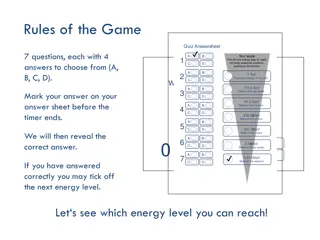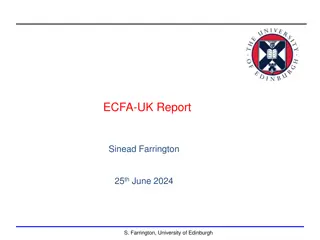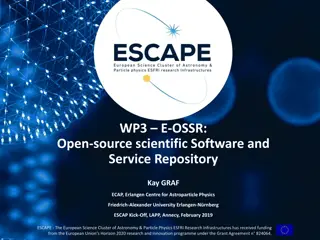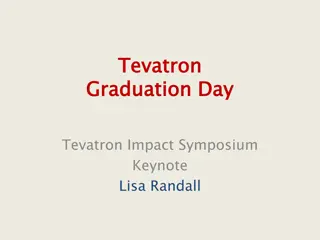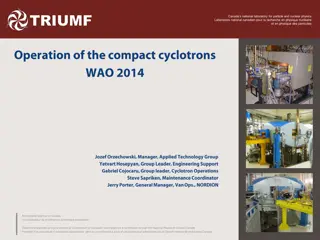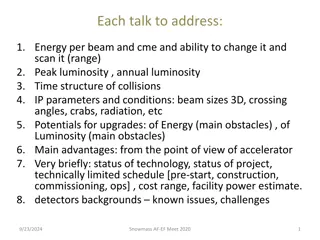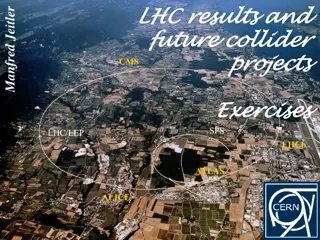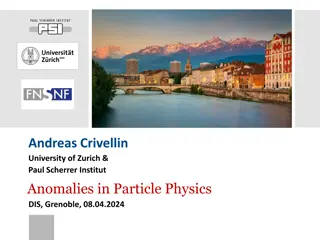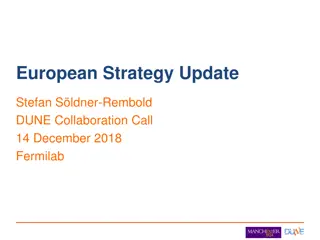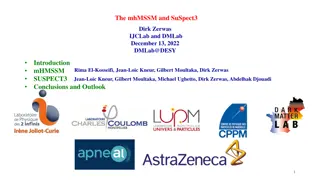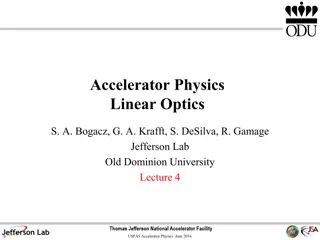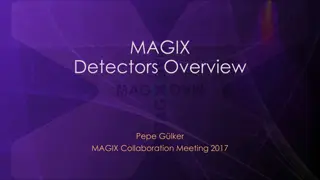Update of European Strategy for Particle Physics: Scenarios and Questions
Briefing book by CERN's Physics Preparatory Group outlines the landscape of particle physics field and proposes five scenarios for future major colliders in Europe, including HL-LHC, CLIC, FCC, LHeC, and LE-to-HE-FCC-h/e/A. The book emphasizes the need for technology decisions and investments to realize these collider scenarios.
Download Presentation

Please find below an Image/Link to download the presentation.
The content on the website is provided AS IS for your information and personal use only. It may not be sold, licensed, or shared on other websites without obtaining consent from the author. Download presentation by click this link. If you encounter any issues during the download, it is possible that the publisher has removed the file from their server.
E N D
Presentation Transcript
SCENARIOS ET QUESTIONS Questions pos es dans le CERN-ESU-005 Towards an update of the European Strategy for Particle Physics I - Sc narios de machines, y compris: renforcement HL-LHC (Q3), programmes cibles fixes (HL-)LHC (Q4), HE-LHC (Q11), participation aux autres machines (Q6), LHeC (Q5), LE-FCC de 6 16T (Q12) II - R&D & travaux th oriques conduire, y compris: aimants haut champ, muon collider, laser-plasma, R&D d tecteurs (Q9), th orie (Q8) III - La plateforme neutrinos: prolongation et revue de son p rim tre (Q7) IV - La diversification, y compris: la diversification type PCB (Q1&Q2), les ondes gravitationnelles (Q10)
CERN-ESU-005 1 Towards an update of the European Strategy for Particle Physics (29 Sept 2019) With a view to update the European Strategy for Particle Physics, the Briefing Book compiled by the Physics Preparatory Group (PPG), based on the submitted inputs and the discussions during the Open Symposium in Granada, provides a summary of the present landscape in the field. It summarises the scientific aspirations, opportunities, as well as technical challenges. Revolving around future major colliders in Europe, at this stage, five scenarios are defined to initiate the discussions within the European Strategy Group (ESG). 5 SCENARIOS 2020-2040 2040-2060 2060-2080 1st gen technology 2nd gen technology CLIC HL-LHC CLIC380-1500 CLIC3000 CLIC-FCC-mixed HL-LHC CLIC380 FCC-h/e/A (Adv HF magnets) FCC HL-LHC FCC-ee (90-365) FCC-h/e/A (Adv HF magnets) LE-to-HE-FCC-h/e/A HL-LHC LE-FCC-h/e/A (LF magnets) FCC-h/e/A (Adv HF magnets) LHeC+FCC-h/e/A HL-LHC + LHeC LHeC FCC-h/e/A (Adv HF magnets) All elements related to the CLIC and FCC proposals are discussed in their respective CDRs. The LE-to-HE-FCC-h/e/A scenario moves from initially lower-field magnets in the window of 6-10T (e.g. adiabatically) to higher-field magnets, potentially HTS magnets. The LHeC+FCC-h/e/A scenario assumes that an electron-positron collider is built outside Europe and that the time gap between the end of HL-LHC and the realisation of the high-energy FCC-h/e/A can be used for the LHeC programme, potentially even starting in parallel with the HL-LHC. For each scenario a new collider would be operational in Europe in the 2040-2060 era, i.e. as short as possible after the HL-LHC or for the scenario including LHeC even before. The community needs to provide guidance for this strategy update for the technology it favours for the 1st generation collider at CERN, leaving options for the 2nd generation open. In general, around 2045 the community will have to consider which technologies are available for high- energy and high-luminosity colliders in the 2060-2080 era and plan accordingly. No firm technology decision for the 2060-2080 era is required today. The chosen scenario will have to be reassessed at the time of the next strategy update, typically 7 years after the current one, taking into account the global context (e.g. ILC, CEPC, EIC, etc). Given significant investments in Accelerator R&D at CERN and elsewhere towards the 1st and 2nd generation technologies, as well as adequate investments in a Scientific Diversity Program at CERN and elsewhere, the annual additional structural and/or in-kind financial effort required to realize the first three collider scenarios is equivalent to 10-13% of the CERN budget in the period from 2025 to about 2045. This assumes that the civil engineering of each scenario is funded from outside the regular CERN budget. For the LE-to-HE-FCC-h/e/A scenario the required investment is not fully understood at this stage, but initial studies indicate that in the period 2025-2045 an additional annual budget equivalent to 20% of the
ESPP : CONTRIBUTION FROM THE FRENCH COMMUNITY - 1/3 2 highest priorities High precision study of Higgs boson and EW sector. New physics through precision FCC-ee physics potential most appealing than CLIC, allowing for Higgs, W, Z, top quark sectors studies, and flavour physics Several detectors will enhance the overall scientific involvement and feedback High energy frontier, exploration for new physics Ultimate goal CERN leadership FCC-hh (eh) is the most ambitious and promising machine Requires a strong, immediate R&D effort on high field magnets What about scenarios ? Scenario 5 -namely running LHeC in the 30 - is not an independent scenario since compatible with scenario 3,4 Scenarii 3+4 (no immediate choice required) answer to the above priorities 06/11/2019 06/11/2018 ESPP : contribution from the French community | PAGE 3
ESPP : CONTRIBUTION FROM THE FRENCH COMMUNITY - 2/3 important considerations If an e+e- machine is decided in Asia, this could allow having e+e-and pp machines running at the same time (in parallel). A clear strategy for Europe could then be to express now a priority for FCC-hh, which can be rediscussed in case Asia is not moving forward on with e+e-(scenario 4) or express now a priority for FCC-ee and jump or not directly to FCC-hh if Asia moves forward with e+e+ (scenario 3) HE-LHC should be kept as an open possibility by supporting strong R&D on magnet (compatible with scenarios 3 and 4 as is LHeC) LHeC: detailed study (financial and technical aspects, community interest) to be pursued. An ambitious bridge (>2030) project, fitting on the different scenarios and exploiting further the LHC investment. Vigorous R&D on ERL machines is needed. 06/11/2018 ESPP : contribution from the French community 06/11/2019 | PAGE 4
ESPP : CONTRIBUTION FROM THE FRENCH COMMUNITY 3/3 Other important aspects FCC-all option should be immediately explored in depth technical feasibility (tunnel, machine) financial aspects (what can be expected from non member states, from other partners, ) (social) acceptability will allow us to be ready for a decision at the next strategy update It is mandatory to have a strong, coordinated action on high field magnets, starting from what is demonstrated up to HTS, with intermediate milestones a key ingredient for the next decisions to be taken Prepare for future possible accelerator technologies, such as ERL (through a PERLE-like demonstrator) or, on longer time scale, muon colliders and laser/plasma acceleration, through a coordinated effort. Important role to be played by national communities. 06/11/2018 ESPP : contribution from the French community | PAGE 5
QUESTIONS Cf slide LV




